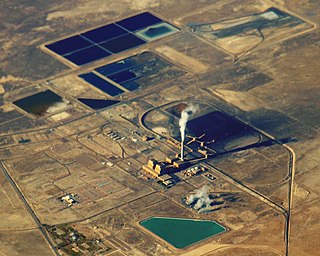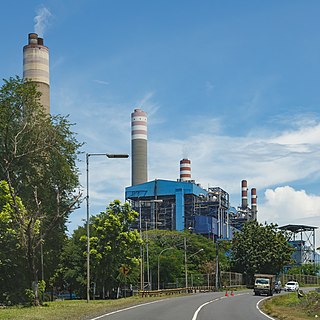Related Research Articles

The 2005 Java–Bali Blackout was a power outage across Java and Bali on 18 August 2005, affecting some 100 million people.

The Hub Power Company Limited, colloquially known as Hubco, is a Pakistani power company based in Karachi, Sindh. It was the first independent power producer (IPP) established in Pakistan, and before the termination of its energy agreement in October 2024, it was the largest IPP in the country.

Walsum power plant is a coal-fired power station owned by Evonik Industries. It is in the Walsum quarter of Duisburg, on the area of the former Walsum coal mine.

PT Perusahaan Listrik Negara (Persero) (lit. 'State Electricity Company', abbreviated as PLN) is an Indonesian government-owned corporation which has a monopoly on electric power distribution in Indonesia and generates the majority of the country's electrical power, producing 176.4 TWh in 2015. It was included in the Fortune Global 500 lists of 2014 and 2015. It has large debts due to expensive coal power contracts.
For solar power, South Asia has the ideal combination of both high solar insolation and a high density of potential customers.
PT Pertamina Gas Negara Tbk is an Indonesian natural gas transportation and distribution company. The total length of distribution pipelines of the company is 3,187 km that serve around 84 million customers.
Birchills power station and Walsall power station are a series of three coal-fired power stations in, or near, Walsall in the West Midlands, England.

The utility electricity sector in Bangladesh has one national grid operated by Power Grid Company of Bangladesh with an installed capacity of 25,700 MW as of June 2022. Bangladesh's energy sector is not up to the mark. However, per capita energy consumption in Bangladesh is considered higher than the production. Electricity was introduced to the country on 7 December 1901.

Geothermal power in Indonesia is an increasingly significant source of renewable energy. As a result of its volcanic geology, it is often reported that Indonesia has 40% of the world's potential geothermal resources, estimated at 28,000 megawatts (MW).

Intermountain Power Plant is a large coal-fired power plant at Delta, Utah, US. It has an installed capacity of 1,900 MW, is owned by the Intermountain Power Agency, and is operated by the Los Angeles Department of Water and Power. The plant includes a HVDC converter. It is scheduled for replacement in 2025 with an 840 MW natural gas plant, designed to also burn "green hydrogen."
The Merangin River is a river in Jambi province, Sumatra island, Indonesia, about 600 km northwest of the capital Jakarta. It is a tributary of the Batang Hari River, through Tembesi River.

In 2019, the total energy production in Indonesia is 450.79 million tonnes of oil equivalent, with a total primary energy supply of 231.14 million tonnes of oil equivalent and electricity final consumption of 263.32 terawatt-hours. From 2000 to 2021, Indonesia's total energy supply increased by nearly 60%.
Mundra Ultra Mega Power Project or Mundra UMPP is a subbituminous coal-fired power plant in Tunda village at Mundra, Kutch district, Gujarat, India. It is the 3rd largest operational power plant in India. The coal for the power plant is imported primarily from Indonesia. The source of water for the power plant is sea water from Gulf of Kutch. The power plant is owned by Tata Power. The special purpose vehicle Coastal Gujarat Power Ltd (CGPL) was incorporated on 10 February 2006.

The electricity sector in Taiwan ranges from generation, transmission, distribution and sales of electricity, covering Taiwan island and its offshore islands.

Paiton Power Station is a large thermal power station located around 35 km to the east of the town of Probolinggo in East Java in Indonesia, about halfway between Probolinggo and Situbondo. The extensive complex has a maximum generating capacity of 4,710 megawatts. It is the largest power station in Indonesia and the 10th largest coal-fired power station in the world.
The Sahiwal Coal Power Project is a coal power plant project located in the province of Punjab in Pakistan by the name of Huaneng Shandong Ruyi (Pakistan) Energy (Limited). It has an installed capacity of 1320 MW. It commenced full operations on 3 July 2017.

PT Bekasi Power is a power plant located in West Java, Indonesia. It is a subsidiary of PT Jababeka Tbk which was established in 2007. As a 130 megawatt (MW) power plant generated by steam and gas (PLTGU), it strengthens Bekasi – Karawang electricity system through Cibatu substation owned by PT Perusahaan Listrik Negara (PLN). This state-owned company can only meet the needs of about 60 percent. To meet the rest, private sector needs to get involved. A reliable and sustainable electricity supply with an international standard is a must for an industrial estate. Bekasi Power plant is therefore constructed to guarantee Uninterruptible Power Supply (UPS) for a total of seven industrial zones including Jababeka. By delivering reliable electricity at a competitive price, this plant supports Jababeka business as well as surrounding areas, boosting Indonesia's power capacity and industrial growth for the upcoming years.
Burning of charcoal and wood fuel provides approximately 94 percent of the energy in Malawi. Much of the renewable hydroelectric potential of the country is untapped. As per 2018 Population and Housing Census, the national electrification rate in Malawi was 10%, with 37% of the urban population and only 2% of the rural population having access to electricity.

The 2019 Java blackout was a power outage that occurred across much of Java on August 4, 2019 11:50 (UTC+7) to August 5, 2019 at 22:00 (UTC+7).
References
- ↑ Amahl S. Azwar, Cirebon power plant on stream for Java and Bali', The Jakarta Post, 19 October 2012.
- ↑ "Hyundai E&C Wins US$727 Million Deal to Build Power Plant in Indonesia". Business Korea. 21 November 2015.
- ↑ "ADB and Indonesia Partners Sign Landmark MOU on Early Retirement Plan for First Coal Power Plant Under Energy Transition Mechanism". Asian Development Bank. 2022-11-14. Retrieved 2023-07-19.